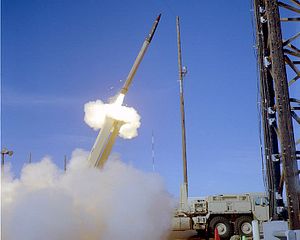The United States and South Korea have officially started working group-level talks about the deployment of a U.S. missile defense system on South Korea soil. The deployment of Terminal High Altitude Area Defense (THAAD) to South Korea has been a possibility for several years, but this year’s nuclear and missile tests from North Korea finally pushed Seoul to move forward – despite China’s strong opposition.
The joint working group held their first meeting at South Korea’s Ministry of National Defense on Friday. According to Yonhap News, the discussion centered on the question of THAAD’s military effectiveness. The working group, headed by Maj. Gen. Jang Kyung-soo, director-general of South Korea’s Defense Ministry, and Maj. Gen. Robert Hedelund, commander of U.S. Marine Corps Forces Korea, will also discuss the timeline, potential deployment sites, and costs. A statement from the South Korean Defense Ministry made it clear, however, that U.S. Forces Korea (USFK) will be in charge of operating THAAD.
Previously, the two sides had pegged February 23 as the potential start date for talks. However, that date was pushed back – in an attempt to win Chinese cooperation on new UN sanctions against North Korea, some argued. U.S. Assistant Secretary of State for East Asian and Pacific Affairs strongly refuted that view, telling reporters that “There’s no connection between what is going on in the diplomatic track in the U.N. Security Council and the question of the deployment of THAAD…THAAD is not a diplomatic bargaining chip.”
Whatever the cause of the delay, the THAAD working group didn’t hold its first meeting until after the UN Security Council, which includes both China and the United States, had unanimously passed new sanctions on North Korea.
China hasn’t been shy about expressing its “firm” opposition to THAAD. Friday was no exception. When asked about the start of the working group talks, Foreign Ministry spokesperson Hong Lei told reporters, “We are firmly opposed to the deployment of the THAAD system on the Korean Peninsula, and urge relevant parties to act cautiously. No harm shall be done to China’s strategic security interests.”
Wu Dawei, China’s special representative for the Korean Peninsula, brought up the THAAD issue during his recent visit to Seoul. During a meeting with South Korean Foreign Minister Yun Byung-se, Wu said that he hoped South Korea would “handle the concern of the Chinese side appropriately.”
China’s opposition to THAAD isn’t the only potential roadblock. Many of the details will be tricky to work out. According to Defense News, a single THAAD unit – which includes “six truck-mounted launchers, 49 interceptors, a fire control and communications unit, and an AN/TPY-2 radar” – would cost $1.6 billion; the United States and South Korea will have to work out how to divvy up those costs. Meanwhile, Yonhap notes that several cities pegged as potential deployment sites for THAAD have already objected, saying they are concerned about the health implications of the radar system’s electromagnetic waves.

































